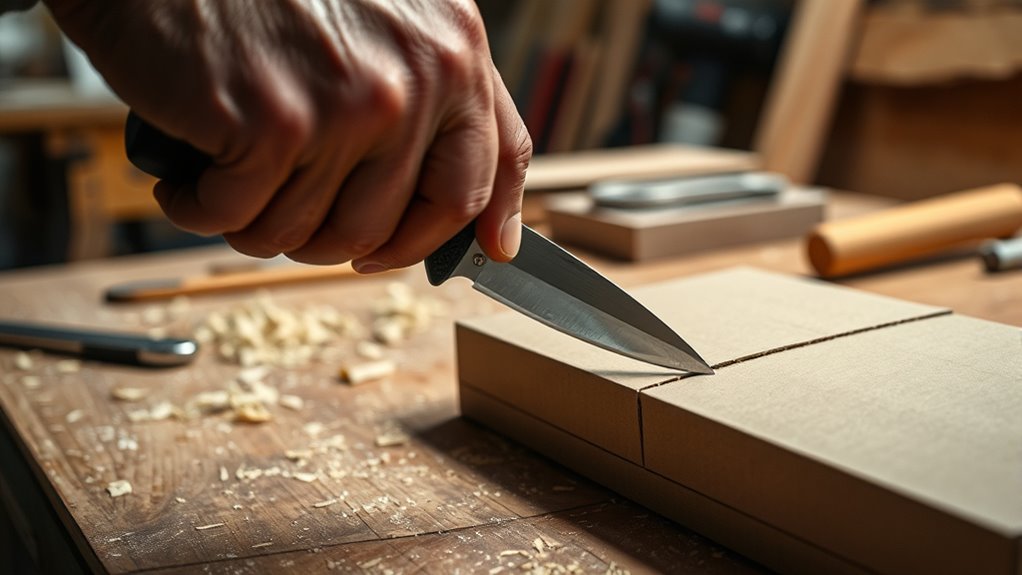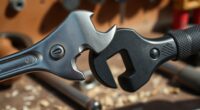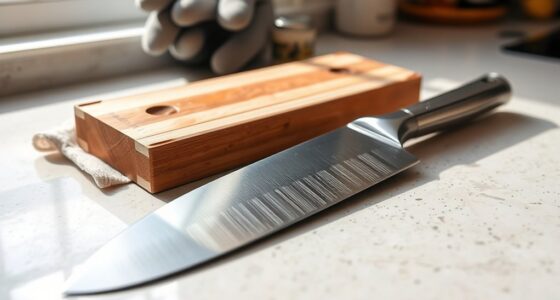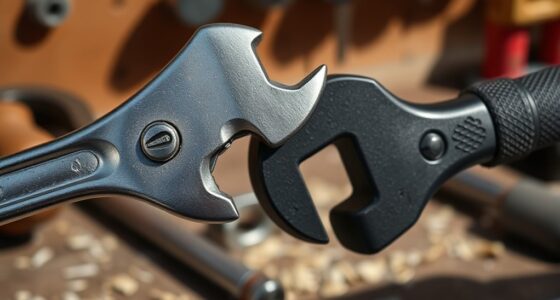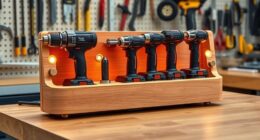When choosing a utility knife, consider the blade type, handle comfort, and overall construction for durability and safety. Opt for a model with a secure locking mechanism and ergonomic grip to reduce fatigue. Remember to keep blades sharp, cut away from your body, and store the knife safely after use. Proper technique and maintenance guarantee precise cuts and longer tool life. Continue exploring to discover expert tips for safe and effective utility knife use.
Key Takeaways
- Select a knife with an ergonomic handle and a durable construction for comfort and safety during extended use.
- Choose the appropriate blade type (stainless or carbon steel) based on your cutting needs and maintenance preferences.
- Always ensure the blade is securely locked before use and retract or cover it after to prevent accidents.
- Use proper cutting techniques, applying steady pressure and cutting away from your body for precision and safety.
- Regularly maintain and replace blades to keep your utility knife sharp, safe, and effective for long-term use.
Factors to Consider When Selecting a Utility Knife
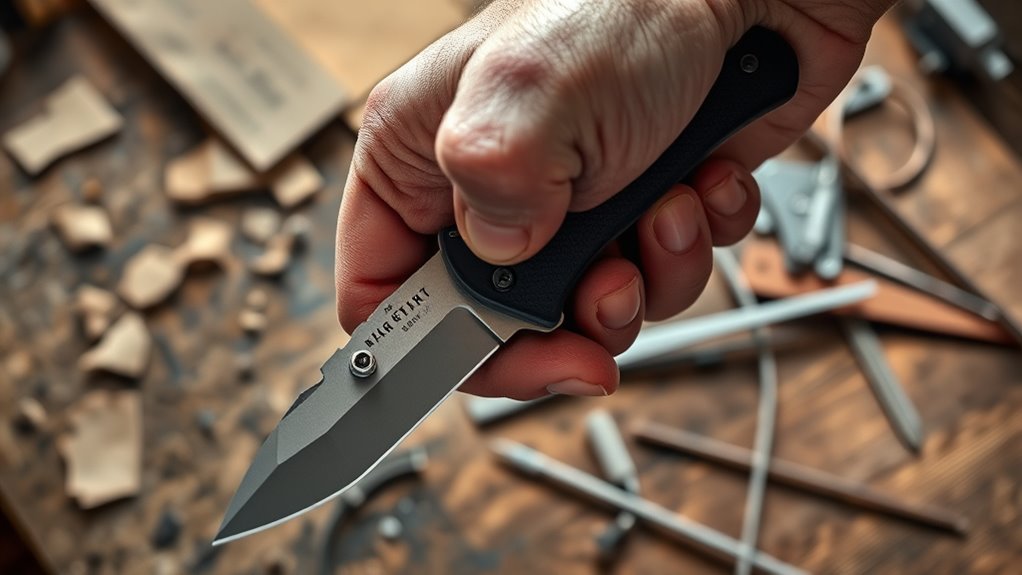
When choosing a utility knife, you should consider factors like blade type, handle comfort, and construction quality. An ergonomic grip is essential for reducing hand fatigue during extended use, so look for a knife with a handle designed to fit comfortably in your hand. The blade material also matters; high-quality steel blades, such as stainless steel or carbon steel, stay sharp longer and are easier to maintain. Confirm the handle provides a secure grip, especially if you’ll be working on tough materials. Durable construction ensures the knife withstands regular use without loosening or breaking. Additionally, considering the divorce statistics and regional legal resources can remind you of the importance of choosing tools that offer safety and reliability, much like selecting a dependable utility knife. By paying attention to these factors, you’ll select a utility knife that offers both comfort and performance, making your tasks safer and more efficient.
Types of Utility Knives and Their Uses
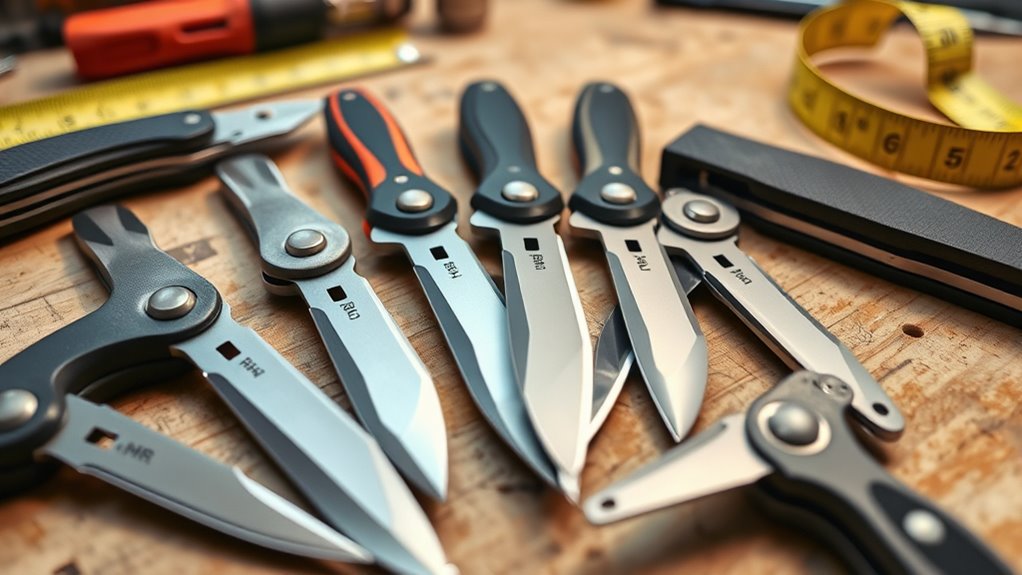
Utility knives come in various types, each designed for specific tasks to maximize efficiency and safety. For example, retractable knives are great for general cutting tasks, while fixed-blade models offer durability for heavy-duty jobs. Blade materials vary from stainless steel, which resists corrosion and maintains sharpness, to carbon steel for sharper edges but less rust resistance. Ergonomic designs ensure comfort and better grip during prolonged use, reducing fatigue. Some knives feature lightweight handles for precision, while others have textured grips for safety. Specialty utility knives, like drywall or ceramic cutters, cater to specific materials. Choosing the right type depends on your task, but considering blade materials and ergonomic features guarantees you get a tool that performs well and feels comfortable in your hand. Incorporating AI technology in tool design can also improve safety features and usability.
Safety Precautions for Handling Utility Knives
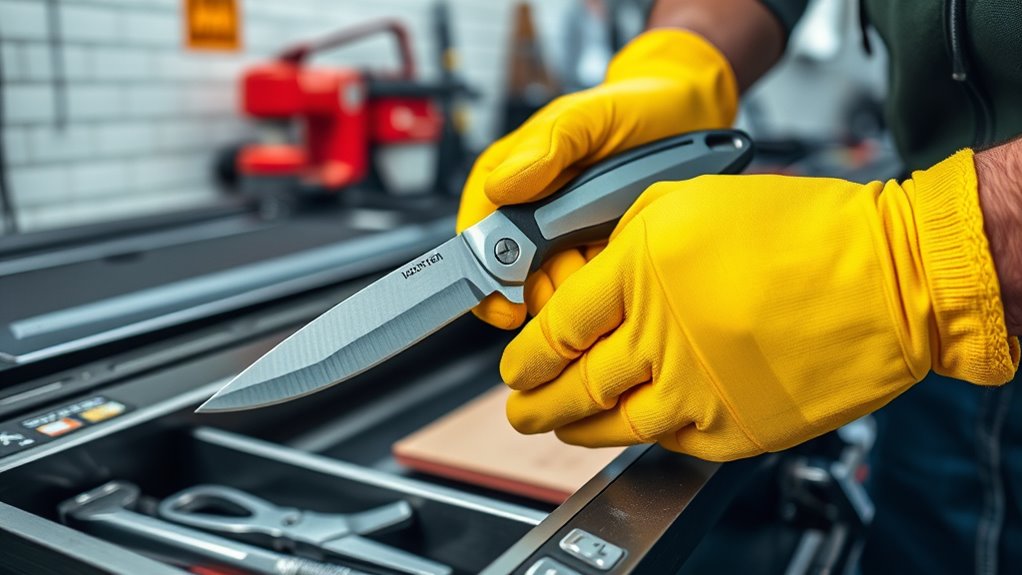
Handling utility knives safely is vital to prevent injuries and guarantee effective work. Always verify the blade is securely locked in place before use; a blade locking mechanism keeps the blade stable during cutting, reducing the risk of slips. When finished, activate the blade locking feature and retract or cover the blade immediately for storage safety. Store your utility knife in a designated, secure location away from children and pets, ideally in a toolbox or drawer with blade covers. Never carry a utility knife loosely or leave it lying around. Wear protective gloves if necessary, and always cut away from your body. By following these safety precautions, you minimize accidents and keep your work environment safe.
Techniques for Effective and Precise Cutting
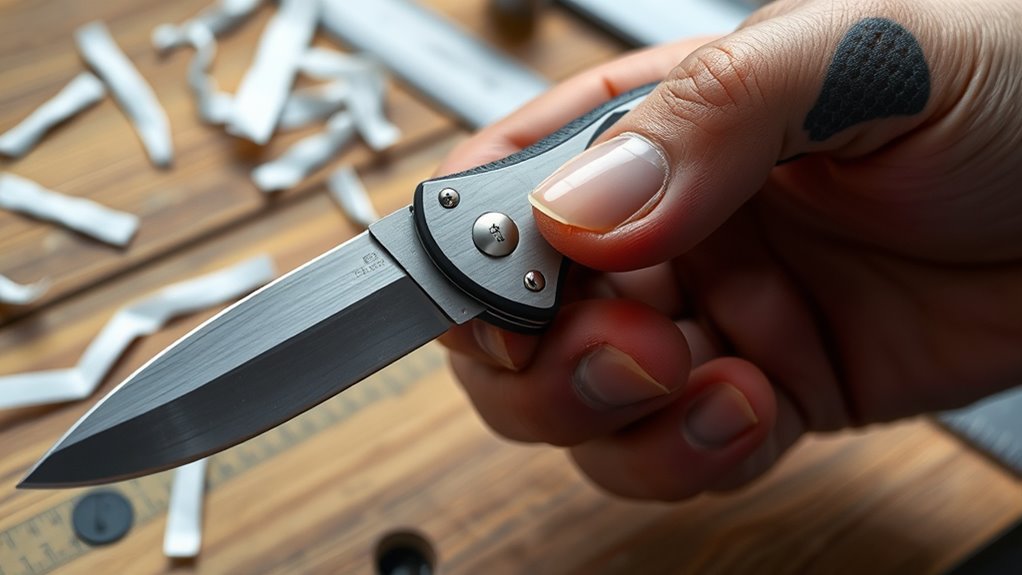
To achieve clean and accurate cuts with a utility knife, focus on proper technique and steady control. Keep your blade sharp through regular blade sharpening; a dull blade requires more force and increases the risk of slips. Use ergonomic handles to maintain a comfortable grip, which enhances precision and reduces hand fatigue. When cutting, apply consistent pressure, and guide the knife slowly along your marked line, avoiding sudden movements. Maintain a stable stance and use your whole arm rather than just your wrist for better control. Always cut away from your body and keep your fingers clear of the blade’s path. Practicing these techniques will improve your accuracy and safety, ensuring each cut is smooth and precise. Additionally, choosing the right Porsche Tuning tools and accessories can enhance your work quality and efficiency.
Maintenance and Blade Replacement Tips
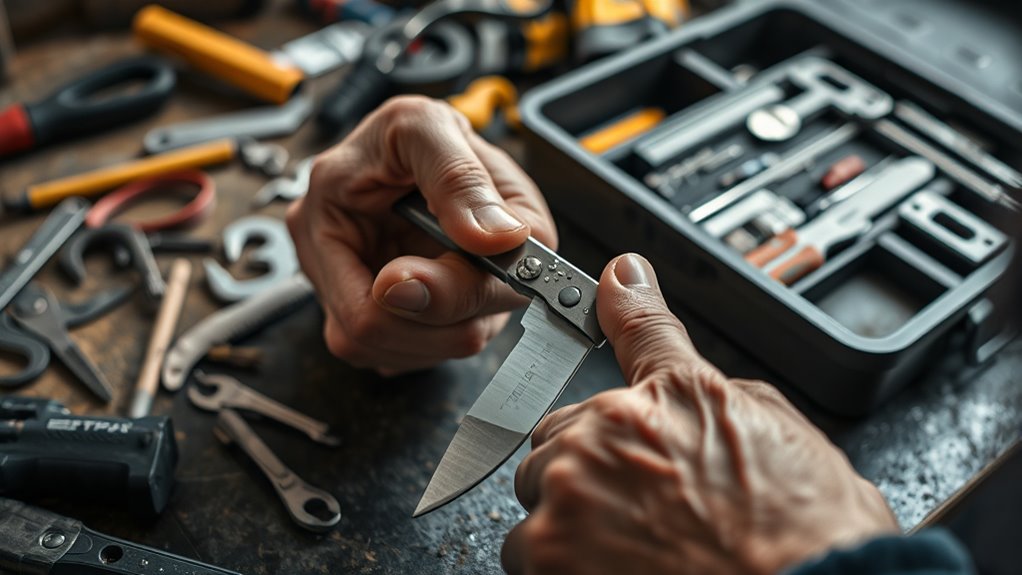
Regular maintenance and timely blade replacements are essential for keeping your utility knife performing at its best. To guarantee maximum sharpness, consider blade sharpening whenever you notice dullness or difficulty cutting. Sharp blades make your work safer and more efficient. When replacing blades, always use the correct type and handle them carefully to avoid injury. Proper storage solutions also help extend your utility knife’s lifespan—store it in a dry, secure place, preferably in a dedicated case or holder to prevent damage and corrosion. Regularly inspect your knife and blades for signs of wear or rust, and replace blades promptly for safety. Additionally, understanding the importance of proper tuning can help in maintaining optimal performance of your tools and equipment. Keeping your utility knife well-maintained not only improves performance but also prolongs its usability, saving you money in the long run.
Frequently Asked Questions
How Do I Choose the Right Utility Knife for My Project?
When selecting a utility knife, you want one that suits your project needs. Look for an ergonomic grip to guarantee comfort during use and better control. Consider blade material—stainless steel blades are durable and resistant to rust, making them ideal for heavy-duty tasks. Think about the type of cuts you’ll make and choose a knife with a blade that matches those needs. This way, you’ll work efficiently and safely.
What Features Distinguish Professional-Grade Utility Knives From Basic Models?
Think of professional-grade utility knives as the sharpest swords in your toolbox. They stand out with blade durability that withstands heavy-duty use and ergonomic design that offers comfort during extended work. Unlike basic models, these knives often feature replaceable blades and sturdy construction, ensuring longevity and precision. You’ll notice a smoother, safer cut, making your projects more efficient and less tiring. It’s like upgrading from a garden trowel to a precision scalpel.
Are There Eco-Friendly or Biodegradable Utility Knife Options Available?
You’ll find that eco-friendly utility knives are available, offering biodegradable alternatives made from sustainable materials like bamboo or recycled plastics. These options help reduce environmental impact while still providing durable, effective tools. By choosing utility knives crafted with eco-friendly materials, you support sustainability and minimize waste. Always check product labels or ask suppliers for biodegradable alternatives, so you can make environmentally conscious choices without sacrificing performance or safety.
How Can I Tell When It’s Time to Replace My Utility Knife Blade?
Think of your utility knife blade like a trusted compass. When it dulls, it loses its direction, making your work harder and riskier. Keep an eye on blade maintenance; if cuts become jagged or require more force, it’s time to substitute it. Doing so ensures safety precautions are maintained, preventing accidents. Regularly inspecting your blade helps you work efficiently and safely, just like having a reliable compass guides your journey.
Can Utility Knives Be Used Safely for Opening Packages or Boxes?
You can safely open packages or boxes with a utility knife by following safety precautions and proper handling. Always make sure the blade is sharp to reduce the risk of slips, and cut away from your body. Wear gloves if needed, and keep your hands clear of the cutting path. Use a stable surface, and don’t rush the cut. These safety measures help prevent accidents and make sure safe package opening.
Conclusion
Choosing the right utility knife is like finding the perfect key to unlock your project’s potential. With the right grip and safety habits, you’ll wield it like a master craftsman, carving through tasks with confidence and precision. Keep it sharp, handle it with care, and let your skills turn each cut into a work of art. Remember, a well-chosen knife isn’t just a tool—it’s your partner in bringing ideas to life.
